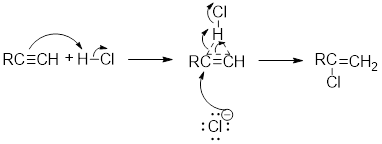
Concept explainers
(a)
Interpretation:
The product obtained from reaction
Concept Introduction:
Electrophile: Electrophiles are electron deficient compounds which accepts electrons from nucleophiles that results in bond formation.
Addition of hydrogen halides to
Electrophilic addition of hydrogen halide to alkyne occurs according to the following general mechanism.

First a
(b)
Interpretation:
The product obtained from reaction
Concept Introduction:
Addition of hydrogen halides to alkynes:
Electrophilic addition of hydrogen halide to alkyne occurs according to the general mechanism.

First a
(c)
Interpretation:
The product obtained from reaction
Concept Introduction:
Acid Catalysed addition of water: When water is added to alkyne in the presence of an acid, the product formed will be an enol. Enol contains a double bond and a
If a carbonyl group is bonded to two alkyl groups, it is called as a
Conversion of terminal alkynes into enol: If we want to convert terminal alkyne into an enol, the presence of mercuric ion as a catalyst should be needed and the catalyst will increase the

(d)
Interpretation:
The product obtained from reaction
Concept Introduction:
Deprotonation: The reaction in which proton is removed from the compound using reagents is known as deprotonation.
Different reagents are used for the deprotonation and one of the common reagents is sodium amide.
Lindlar catalyst: The catalyst is used for the hydrogenation of alkynes in a syn manner. This means both hydrogen are added on the same side across the triple bond and the product obtained will be a cis product.
Sodium in liquid ammonia: The catalyst is used for the formation of trans
(e)
Interpretation:
The product obtained from reaction
Concept Introduction:
Deprotonation: The reaction in which proton is removed from the compound using reagents is known as deprotonation.
Different reagents are used for the deprotonation and one of the common reagent is sodium amide.
Lindlar catalyst: The catalyst is used for the hydrogenation of alkynes in a syn manner. This means both hydrogen are added on the same side across the triple bond and the product obtained will be a cis product.
Sodium in liquid ammonia: The catalyst is used for the formation of trans alkenes from alkynes. Because of its more reactivity towards triple bonds, the reaction will stop at the formation of alkenes.
(f)
Interpretation:
The product obtained from reaction
Concept Introduction:
Deprotonation: The reaction in which proton is removed from the compound using reagents is known as deprotonation.
Different reagents are used for the deprotonation and one of the common reagents is sodium amide.
Lindlar catalyst: The catalyst is used for the hydrogenation of alkynes in a syn manner. This means both hydrogen are added on the same side across the triple bond and the product obtained will be a cis product.
Sodium in liquid ammonia: The catalyst is used for the formation of trans alkenes from alkynes. Because of its more reactivity towards triple bonds, the reaction will stop at the formation of alkenes.
Want to see the full answer?
Check out a sample textbook solution
Chapter 6 Solutions
EP ESSENTIAL ORG.CHEM.-MOD.MASTERING
- Calculate the chemical shifts in 13C and 1H NMR for 4-chloropropiophenone ? Write structure and label hydrogens and carbonsarrow_forwardPlease sirrr soollveee these parts pleaseeee and thank youuuuuarrow_forwardPlease sirrr soollveee these parts pleaseeee and thank youuuuu, don't solve it by AI plleeaasseeearrow_forward
- Please sirrr soollveee these parts pleaseeee and thank youuuuuarrow_forward4. Read paragraph 4.15 from your textbook, use your calculated lattice energy values for CuO, CuCO3 and Cu(OH)2 an explain thermal decomposition reaction of malachite: Cu2CO3(OH)2 →2CuO + H2O + CO2 (3 points)arrow_forwardPlease sirrr soollveee these parts pleaseeee and thank youuuuuarrow_forward
- III O Organic Chemistry Using wedges and dashes in skeletal structures Draw a skeletal ("line") structure for each of the molecules below. Be sure your structures show the important difference between the molecules. key O O O O O CHON Cl jiii iiiiiiii You can drag the slider to rotate the molecules. Explanation Check Click and drag to start drawing a structure. Q Search X G ©2025 McGraw Hill LLC. All Rights Reserved. Terms of Use F 3 W C 3/5arrow_forward3. Use Kapustinskii's equation and data from Table 4.10 in your textbook to calculate lattice energies of Cu(OH)2 and CuCO3 (4 points)arrow_forward2. Copper (II) oxide crystalizes in monoclinic unit cell (included below; blue spheres 2+ represent Cu²+, red - O²-). Use Kapustinski's equation (4.5) to calculate lattice energy for CuO. You will need some data from Resource section of your textbook (p.901). (4 points) CuOarrow_forward
- What is the IUPAC name of the following compound? OH (2S, 4R)-4-chloropentan-2-ol O (2R, 4R)-4-chloropentan-2-ol O (2R, 4S)-4-chloropentan-2-ol O(2S, 4S)-4-chloropentan-2-olarrow_forwardIn the answer box, type the number of maximum stereoisomers possible for the following compound. A H H COH OH = H C Br H.C OH CHarrow_forwardSelect the major product of the following reaction. Br Br₂, light D Br Br Br Brarrow_forward
 ChemistryChemistryISBN:9781305957404Author:Steven S. Zumdahl, Susan A. Zumdahl, Donald J. DeCostePublisher:Cengage Learning
ChemistryChemistryISBN:9781305957404Author:Steven S. Zumdahl, Susan A. Zumdahl, Donald J. DeCostePublisher:Cengage Learning ChemistryChemistryISBN:9781259911156Author:Raymond Chang Dr., Jason Overby ProfessorPublisher:McGraw-Hill Education
ChemistryChemistryISBN:9781259911156Author:Raymond Chang Dr., Jason Overby ProfessorPublisher:McGraw-Hill Education Principles of Instrumental AnalysisChemistryISBN:9781305577213Author:Douglas A. Skoog, F. James Holler, Stanley R. CrouchPublisher:Cengage Learning
Principles of Instrumental AnalysisChemistryISBN:9781305577213Author:Douglas A. Skoog, F. James Holler, Stanley R. CrouchPublisher:Cengage Learning Organic ChemistryChemistryISBN:9780078021558Author:Janice Gorzynski Smith Dr.Publisher:McGraw-Hill Education
Organic ChemistryChemistryISBN:9780078021558Author:Janice Gorzynski Smith Dr.Publisher:McGraw-Hill Education Chemistry: Principles and ReactionsChemistryISBN:9781305079373Author:William L. Masterton, Cecile N. HurleyPublisher:Cengage Learning
Chemistry: Principles and ReactionsChemistryISBN:9781305079373Author:William L. Masterton, Cecile N. HurleyPublisher:Cengage Learning Elementary Principles of Chemical Processes, Bind...ChemistryISBN:9781118431221Author:Richard M. Felder, Ronald W. Rousseau, Lisa G. BullardPublisher:WILEY
Elementary Principles of Chemical Processes, Bind...ChemistryISBN:9781118431221Author:Richard M. Felder, Ronald W. Rousseau, Lisa G. BullardPublisher:WILEY





